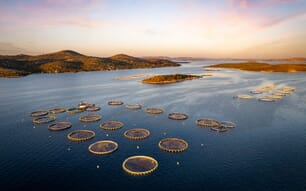“Catch is related to water temperature. Cold weather cuts down on the catch, and extended cold weather negatively affects the growth rates of crawfish,” Mr McClain said.
Mr McClain said once water temperatures go much below 60 degrees, crawfish become less active. Crawfish will not feed well or move around and are less likely to become attracted to the bait in traps.
Cold weather does not present a major mortality issue for crawfish. According to Mr McClain, hot and dry conditions are more of a concern to crawfish producers than cold weather.
“Hot and dry conditions in the late summer and early fall can cause significant mortality for crawfish in their burrows,” Mr McClain said.
If adult crawfish die in their burrows, there will be no young crawfish to emerge in the late fall and early winter when farmers begin to flood their ponds. June 2009 was exceptionally dry, but rainfall was adequate in July and August in most regions. Mr McClain said moisture in the late summer minimised mortality in the burrows, but the results will not be known until later this year.
Mr McClain said the recent cold weather may keep some producers from running their traps.
“The catch will be smaller. And from an economic standpoint, it may not be profitable to harvest intensely,” Mr McClain said.
Fred Zaunbrecher had just begun to run some traps on his farm near Rayne, Louisiana, before the cold’s arrival. But it will be a while before he runs the traps again because of the cold temperatures and the inactivity of the crawfish. Mr Zaunbrecher said that the conditions are just too harsh to harvest, and the small catch does not justify doing it.
Mr Zaunbrecher is optimistic about this year’s upcoming season. Rainfall in October and December drastically reduced the amount of pumping he needed to fill his ponds.
“Mother Nature really helped out there. The rains will definitely reduce my input costs related to pumping,” Mr Zaunbrecher said. “When you put a pencil to it, every little bit of reduction in inputs helps.”
“Up to this point, we have generally had very favorable conditions for crawfish production. A warm fall encouraged growth, and periodic rains filled and refreshed ponds and helped maintain water quality,” Mr McClain said. “Conditions in the Atchafalaya Basin have also been conducive for our wild crawfish.”
While conditions point to a good crawfish season, the unusually cold weather, if prolonged, will negatively affect the harvest for the near future. Until warmer weather returns for an extended period and while water temperatures remain below 60 degrees, consumers can expect to see fewer crawfish on the market and to pay a higher price for the crustaceans.
Cold Weather Hampers Crawfish Harvest
US - Well-below-average temperatures in January will influence the crawfish harvest significantly, according to Louisiana AgCenter researcher Ray McClain.

